Post by aerofoto - HJG Admin on Nov 18, 2006 4:45:47 GMT
Despite development of the DC8 commencing later than B707 and resulting perception the aircraft was forced to play catch-up with Boeing throughout its production life, in reality Douglas's vast experience in both construction of civil aircraft and the world airline industry stood DC8 development somewhat in advance ...to challeng Boeing and influence the B707 design throughout early production years.
The commercial jet age was born during 1952 when COMET 1 first entered BOAC service. Boeing at this time was already well advanced with its B367-80 demonstrator ...which it intended developing for both military and civil service. However there were many within both Douglas and the world airline industry whom remained skeptical about the propliner era being over and jets being the future of world civil aviation. A sizeable backlog of both DC6 & DC7 orders, the early COMET 1 tradgedies, and other logistical/economic concerns tended to justify such conservatism. Never-the-less Douglas began studying jet concepts from 1952, and like Boeing was a participant in the May 1954 USAF tender/RFP for a jet powered aerial refueller with its original DC8 proposal ...also aimed at both military and civil markets. 2 versions of this new aircraft design were proposed under "DC8-A" & "B" designations intended for domestic and overwater operations respectively. Douglas's new jetliner design conformed to a swept wing 4 engine configuration similar to that of B367-80 and featured a fuselage length of 131ft 3in, wingspan of 130ft, cabin width of 11ft, capacity for 76-110 PAX, MTOW of between 209,000lbs-249,000lbs, P&W JT3 & JT4 series turbojet powerplants, and a maximum payload range of some 3,000nm-4,000nm. The "DC8-B" specification differed from the "A" version being equipped with external underwing fuel tanks.
To Douglas's shock the USAF jet tanker contract was eventually awarded to Boeing ...essentially because having closely collaborated with the air force throughout both KC97 and B367-80 development, and by this time some 2 years in advance of its competitors, Boeing had already successfully designed and produced a suitable jet aircraft at a time most needed by the US military (B367-80 first flew on July 15 1954 ...some 2 months after the USAF RFP was first issued) whilst Douglas, despite the unquestionable reputation of its aviation engineering was still at the paper plane stage of developing its own aircraft bid. For Boeing, having also successfully developed and trialled the Flying Boom method of aerial refuelling, refinning B367-80 into what ultimately became B717/KC135 was a relatively short and simple transition. Douglas had unfortunately believed the US military would likely favour more than 1 manufactuer with regard to its tender. Loosing this lucrative USAF contract for what amounted to some 820 airframes was a critical blow to Douglas from which the company would never fully recover.
Although financially disadvantaged without the benefit of Boeing's significant government/military investment, Douglas never-the-less formally announced its DC8 program on July 7 1955 as a direct challenge to the B707 civil development of Boeing's B367-80/KC135-A and at an estimated cost of some $450 million which it had to fund independantly. In fact Douglas was not only to build a new jetliner but also forced to relocate from Santa Monica to Long Beach California to construct new facillities in support of its DC8 program. Around this time General Dynamics was also preparing to launch its CV880 jetliner. By this time the world airline industry was slowly being won over to the concept of jet air travel. For Douglas it was a case of go ahead or be left behind. In consultation with airlines around the world Douglas's original 1954 DC8 specification was progressively enhanced, evolving into an aircraft with a fuselage length of 150ft 6in, wingspan of 139ft 9in, capacity for 122-144 PAX, MTOW of between 265,000lbs-287,000lbs, and either P&W JT3C or P&W JT4A series turbojet powerplant options.
Despite its late start the Douglas design quickly found favor with many airlines for its wider cabin (increased to 11ft 6in) and immediate marketing of both domestic and overwater versions of the DC8 ...each of identical dimensions but varying operating weights and powerplant options. This consequently forced Boeing to increase cabin width of its B707 in order to remain competitive. Boeing also countered by tailoring B707's fuselage length in response to specific airline preferences. Douglas's failure to similarly compromise its basic aircraft specification, despite having designed significant stretch potential into the DC8, seriously disadvantaged aircraft sales throughout the first several years of production. Launch customer for the DC8 was Pan American World Airways with an order for 25 aircraft announced on October 13 1955. Whilst Douglas had been shocked at loosing the USAF tender to Boeing ...Boeing were equally peturbed when Pan American committed to DC8-30's on the same day it also ordered 20 B707-120's. Another large order was forthcomming from United Airlines on October 25 1955 for 30 DC8-10's. Orders quickly followed from other airlines around the world many of whom were long established and loyal Douglas clientele.
The DC8's first flight was originally planned for December 1957, with airline deliveries commencing during 1959. Construction of the first airframe began during September 1956. The DC8's fuselage was a double lobe structure comprising of titanium anti-tear strips around each frame and window/door appeture promoting a fuselage of incredible strength and durability. It also featured larger (18.5in X 15in) cabin windows than B707 spaced at 1 per seat row in often varying configurations specific to airline requirements. The DC8's wing also had less sweep than that of B707 ...for 30 degrees... compared with Boeing's 35 degree wing sweep. A number of modifications were innevitably incorporated into the DC8 design during construction of the first airframe and these ultimately delayed the aircrafts first flight until well into 1958. Although Boeing could offer more competitive aircraft pricing, Douglas had by late 1957 amassed 135 firm DC8 orders compared with 150 B707 commitments by this time accumulated by Boeing. DC8's had also been sold to more airlines than Boeing had sold B707's ...the battle of the jetliners was proving as interesting as it was close.
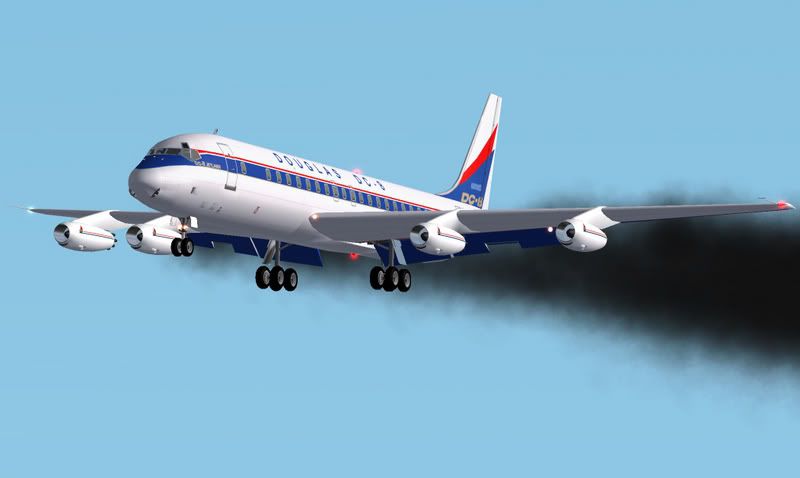
DC8 "Ship One" (N8008D) was finally rolled-out at Long Beach Califorina on April 9th 1958 and first flew on May 30 1958. Flight testing proceeded from Edwards AFB California until August 31 1959 when FAA type certification was approved for the DC8-10. At the time of flight testing engine thrust reversers were not available. The aircraft was instead equipped with 2 large air-brake doors located on the lower rear fuselage (port and starboard sides) immediately behind the wing trailing edge. Extending outwards when fully deployed these used the aircrafts slipstream to assist decelleration during roll-out after landing. Proving almost completly ineffective they were quickly deleted from the DC8 design when engine thrust reverser systems were developed. Early flight testing revealed the DC8 could not meet its intended 567mph cruising speed ...falling some 30mph short of Douglas's garunteed performance. Drag problems impairing speed were rectified through development of revised wing tips which were first flown on February 17 1960. Other improvements were also incorporated into the DC8's wing design throughout the test flying of later aircraft models. On May 14 1959 tests to ascertain maximum safe sink/landing rates suddenly revealed a structural weakness in the DC8 fuselage. DC8-20 "Ship Two" (N8018D), suffered a broken keel beam when the aircrafts fuselage snapped and folded down around the rear wing spar upon touchdown. This incident was non-fatal and the aircraft repaired then returned to service. All production DC8's were consequently strengthened.
In a bid to reduce the DC8/B707 sales gap Douglas intended establishing on the world market a multiplice of DC8 versions each of varying capabilities. Several aircraft participated in the types initial flight testing program which ensured FAA certification of all DC8-10, -20, -30, & -40 models by February 1961. Although Pan American was launch customer for the new jetliner, United Air Lines were first to take delivery on June 3 1959, followed by Delta Air Lines on July 21 1959. Delta also became the first airline to commence scheduled DC8 services on September 18 1959 (New York/Atlanta) ...some 2 hours ahead of United's first DC8 service on the same day.
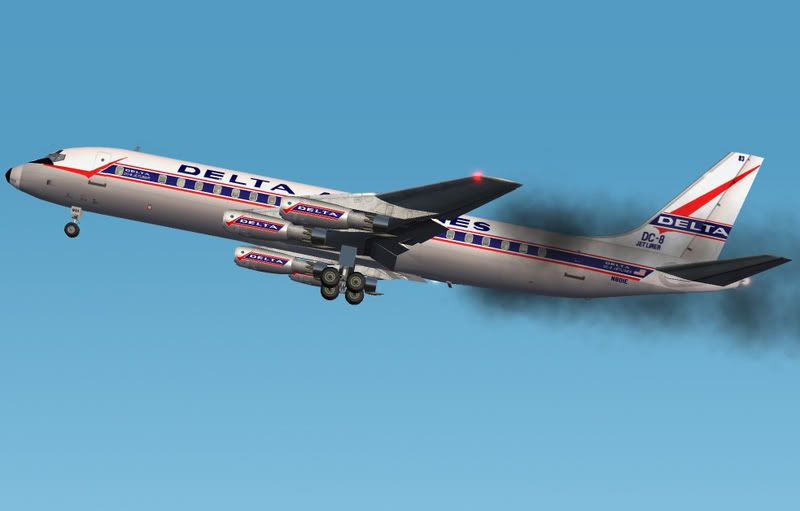
"DC8-10" was the initial production model of the new Douglas jetliner and version first acquired by both Delta Air Lines, and United Air Lines during 1959, delivered as DC8-11's. These aircraft were designed for domestic operations and featured the 139ft 9in wingspan and 265,000lb MTOW of the original DC8 specification. Failure of these early versions to meet garunteed speed/performance forced Douglas to develop reduced drag wing tips for all series 11 aircraft which also increased wingspan by 2ft 8in. Leading Edge Wing Slots were also later incorporated promoting both reduced stalling speeds and a 7,000lb increase in MTOW. Upgraded DC8-11's were redesignated DC8-12's and recertified on July 1 1960. A total of 28 DC8-11's were produced. Most of these were upgraded to -12's whilst the last 5 produced were built to pure -12 specification. A significant number of these aircraft were later converted to series 30 and -50 models during the early 1960's. DC8-12 aircraft had a fuselage length of 150ft 6in, wingspan of 142ft 5in, MTOW of 273,000lbs, capacity for 105-118 PAX in a dual First/Economy Class cabin (depending upon airline configuration), range of some 3,734nm, and were powered by 4 P&W JT3C-6 turbojet engines (with Water/Methanol injection) each rated at 13,500lbs/st.
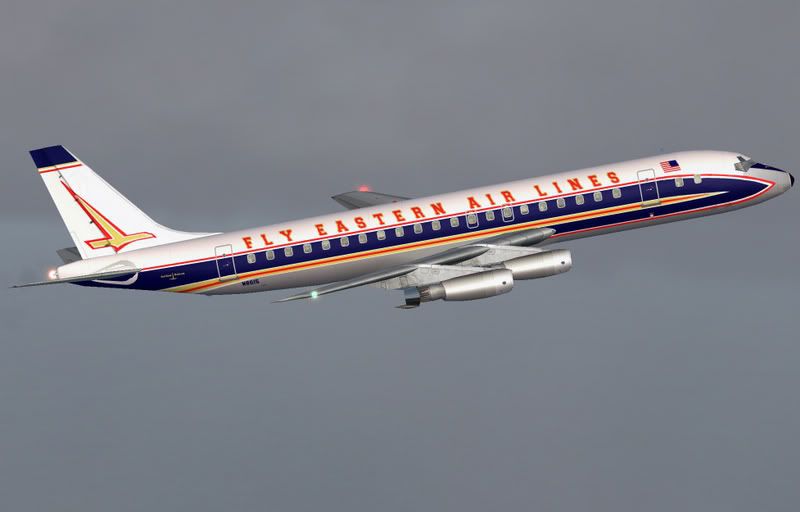
November 29 1959 saw first flight of the "DC8-20" which was approved FAA certification on January 19 1960. Eastern Air Lines, and National Airlines took delivery of the first series 20's on January 3 and February 7 respectively, delivered as DC8-21's. This aircraft represented a more powerful version of the original domestic model intended for hot and high operations. The redesigned wingtips (applied to all DC8's from series 12-61 models) and Leading Edge Wing Slots incoporated into all models from L/n #30 and retrofitted to earlier deliveries, were first trialled on a DC8-20 during the flight testing program. 34 DC8-20's were produced. A number of these were also later upgraded to series 30 and -50 aircraft during the 1960's. A very small number of these aircraft were even converted to freighters during the 1970's, resdesignated DC8-20F and remained in service until the early 1980's such as very rare examples which served Southern-Air Transport, and Aeroleon. DC8-21 aircraft had a fuselage length of 150ft 6in, wingspan of 142ft 5in, MTOW of 276,000lb, capacity for 105-118 PAX in a dual First/Economy Class cabin (depending upon airline configuration), range of some 4,045nm, and were powered by 4 P&W JT4A-3 turbojet engines each rated at 15,800lbs/st. Sensing it was at risk of being outclassed by Douglas, the DC8-20 forced Boeing to respond with B707-220 as an alternative to its underpowered B707-120 until advent of the B707-320.
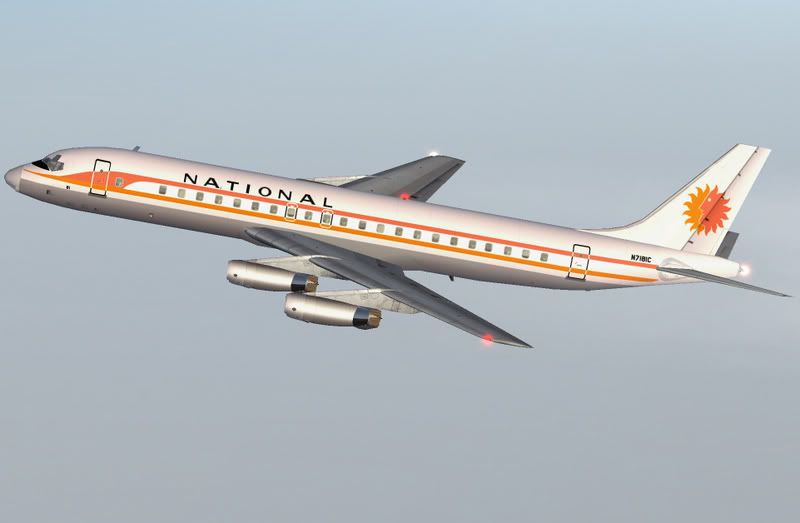
3 versions of "DC8-30" were developed by Douglas and became first of the new intercontinental series aircraft of greater power, operating weights, capacity, and range ...intended to counter B707-320. DC8-31 first flew on February 21 1959 and trialled a 1.5 degree cruise flap setting intended to further improve flight/cruise performance. This modification delayed FAA certification of the series 31 until March 30 1960 but was incorporated into all production DC8's from L/n #33. FAA certification of the higher MTOW DC8-32 was approved on February 1st 1960, followed by the series 33 of further increased MTOW on November 28 1960. Pan American World Airways took delivery of the first series 30 aircraft on February 7 1960, delivered as DC8-32's followed also by the first -33 model on December 15 1960. Pan American Grace Airways took delivery of the first DC8-31 on April 6 1960. The first DC8's for foreign customers also became series 30 aircraft for KLM Royal Dutch Airlines, and SAS, delivered as series 32's on March 19 and 31 1960 respectively. Douglas produced a total of 57 DC8-30's (compared with 69 slightly larger and higher capacity B707-320's built by Boeing). Many of these were upgraded to later model 30 specification and series 50 aircraft throughout the 1960's. Some of these aircraft were converted to freighters during the 1970's, redesignated DC8-30F such as rare examples which served ANDES, and Zantop International. All DC8-30 aircraft had a fuselage length of 150ft 6in, wingspan of 142ft 5in, capacity for 132-144 PAX in a dual First/Economy Class cabin (depending upon airline configuration), range of some 4,700nm. DC8-31's & -32's had a MTOW of 300,000lbs and 310,000lbs respectively and were both powered by 4 P&W JT4A-9 turbojet engines each rated at 16,800lbs/st, whilst series -33 aircraft were certified for up to 315,000lbs MTOW and were powered by P&W JT4A-11 turbojet engines each rated at 17,500lbs/st.

Late 1950's development of fanjet engine technology of improved performance and fuel economy promoted a new generation of both DC8 & B707 jetliners. "DC8-40" became the first of the DC8 family to benefit from this revolutionary new powerplant ...the RR Conway fanjet engine. Like preceeding series 30 aircraft, the -40 model was also produced in 3 versions each of progressively higher operating weights. First flying on July 23 1959 the DC8-41 was approved FAA certification on March 24 1960, followed by the series 42 on April 26 1960, then the -43 model on February 11 1961. The DC8-43 also introduced yet another performance enhancing modification in the form of a 4% wing chord extension (from wing root to tip) with a sharper leading edge promoting slightly higher speed, additional fuel capacity, and increased range. This enhancemnt was incorporated into all production DC8's from L/n #148 and also retrofitted to earlier series 40 aircraft upon airline request. The first DC8-41 was delivered to Trans Canada Airlines on February 7 1960, followed by the first series 42 delivered to Alitalia on April 28 1960, then the first -43 model which was delivered to Canadian Pacific Airlines on February 21 1961. 32 DC8-40's were produced by Douglas between 1959 and 1963 (compared with 37 RR Conway powered B707-420's built by Boeing over a similarly short duration). Again some early -40 series DC8's were upgraded to later 40 model specification and to series 50 aircraft throughout the 1960's. A very small number of these aircraft were also converted to freighters during the 1970's, redesignated DC8-40F such as very rare examples which served AeroPeru Cargo, and ARCA Colombia. All DC8-40 aircraft had a fuselage length of 150ft 6in, wingspan of 142ft 5in, capacity for 132-144 PAX in a dual First/Economy Class cabin (depending upon airline configuration), range of some 4,875nm, and were powered by 4 RR Conway 509 fanjet engines each rated at 17,500lbs/st. DC8-41's had a MTOW of 300,000lbs, whilst series 42 and -43 models were certified for up to 310,000lbs and 315,000lbs MTOW respectively. Both DC8-40 and the RR Conway powerplant were quicky overtaken by further advances in jet engine technology when even higher performance P&W series fanjet engines became available during the early 1960's.
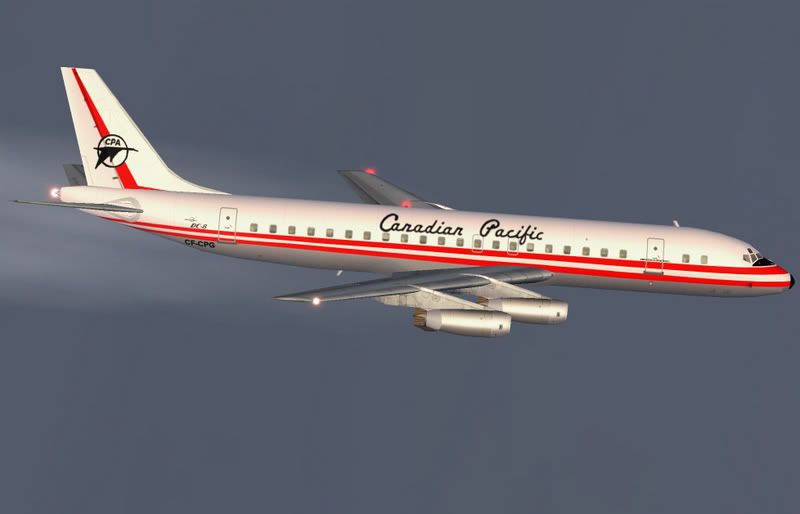
On August 21 1961 a DC8-43 earned distinction of becomming the first civil jetliner to exceed the sound barrier. In a planned/controlled sortie over the Askana Tracking Range at Edwards AFB California, the aircraft attained a speed of MACH 1.012/662mph (TAS) in a shallow dive from FL520 which was also an altitude record for a civil jetliner. This particular aircraft was later delivered to Canadian Pacific Airlines as CF-CPG on November 15 1961 and operated until May 1 1980 when it was finally retired from service and sold for scrap.
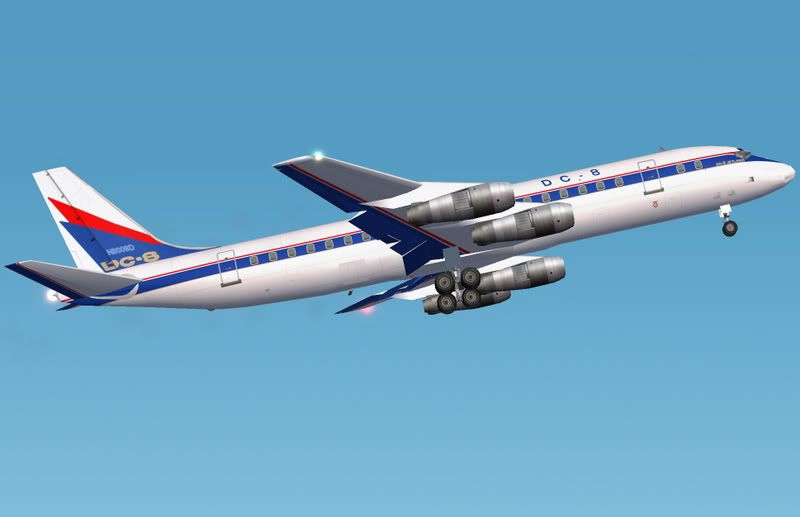
Powered by P&W JT3D series fanjet engines of superior performance, fuel economy, and environmental acceptability, "DC8-50" became the definitive short fuselage DC8 version, produced in several sub types of varying configuration and capability in response to the B707-320B and VC10 then entering the world market. DC8 "Ship One" was upgraded to series 50 specification with new fanjet powerplants contained within redesigned engine nacelles which were attached to the original DC8-10 pylons. First flying in this configuration (but without the aerodynamic enhancements applied to previous DC8 versions) on December 20 1960 the aircraft was approved FAA certification on October 10 1961. All production DC8-50's featured redesigned engine pylons.

3 initial PAX versions of the -50 model were marketed ...DC8-51 first delivered to Trans Canada Airlines on November 6 1961, followed by the increased MTOW -52 certified on May 1 1961 and first delivered to IBERIA on May 27 1961, then the even higher MTOW -53 first delivered to KLM Royal Dutch Airlines on April 3 1961. This particular aircraft (PH-DCI) was delivered early to KLM and operated performance/reliability testing (flying Long Beach/Rome/Amsterdam/Caracus/Long Beach in support of the series 50 type certificate) between April 21 and April 28 1961 when FAA certification was approved for DC8-53.
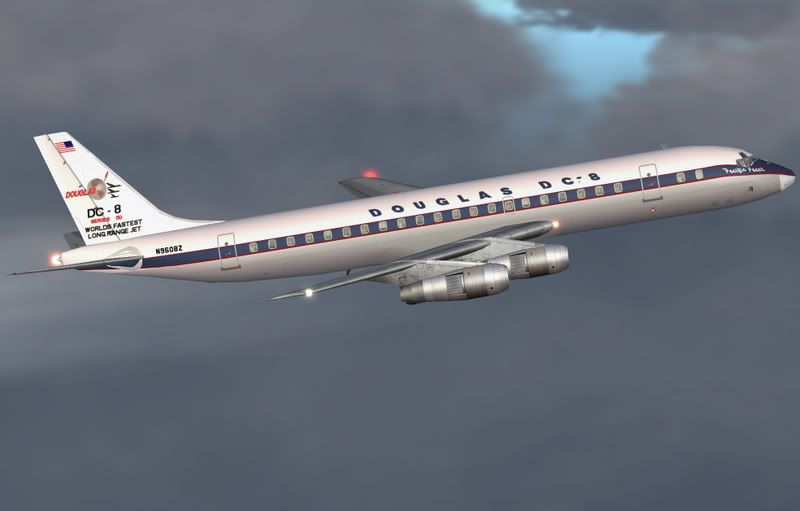
The DC8-50's payload/range capabilities were demonstrated between February 20 and 23 1962 when DC8-53 N9608Z, named "Pacific Pacer" and operated in a promotional Douglas livery, flew Seattle/Tokyo direct with a 41,000lb payload, then Tokyo/Miami direct over a distance of 8,702nm in 13hrs 52mins. Some 10,000lbs of fuel remained aboard the aircraft upon shutdown in Miami. A total of 88 series 51, -52, & -53 DC8's were built by Douglas (in comparason to 174 B707-320B's built by Boeing). An additional number of DC8-20, -30, & -40 models were upgraded to -50 series aircraft during the 1960's. Many of these also were converted to freighters throughout the 1970's and 1980's, redesignated DC8-50F.
Despite its advantages over previous DC8 versions, the DC8-50's entry into the world market also coincided with a global slump in the sales of new jetliners. The rush by most major airlines during the late 1950's to modernize with jet equipment suddenly resulted in a period of excess capacity, experienced by most carriers during the early 1960's. The number of DC8's & B707's sold between 1962 and 1964 dwindled sharply as airlines awaited traffic growth before ordering new aircraft.
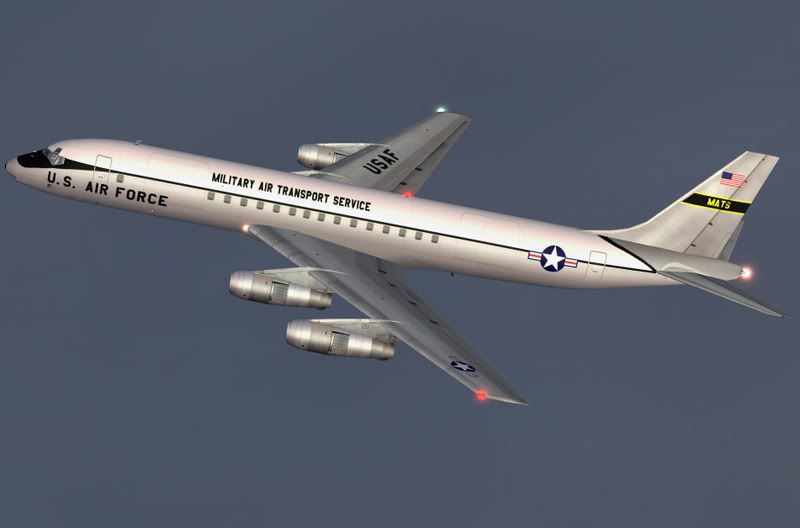
During this period Douglas attempted to market DC8's to the USAF as "JETMASTER" transports, and later as a contender for prospective AWACS, ECM, Anti-Submarine, Aerial Refuelling, and Medical Evacuation roles. Whilst military interest was generated no orders were forthcomming as the USAF elected to remain with Boeing and its established B707 derived C135/Bairframe.

At least 1 DC8 did enter a specialist military tatical air service role. During 1988 the US Navy purchased an ex United Airlines DC8-54F (N8048U L/n #276). This particular aircraft (163050) was upgraded to provide support for Fleet Electronic Warfare Missions/C3 threat simulation as well as general transport deployment. Aquiring the Navy "EC-24A" designation this aircraft was operated by Chrysler Technologies on behalf of the US Navy until decommissioned during 1998.
Douglas might have closed the DC8 production line early had not another niche opportunity been realised. Just as advent of civil jetliners promoted carriage of greater volumes of passengers further and faster than ever before, so too expanded potential for global import/export cargo giving birth to a whole new industry of dedicated jet air freight, to which the DC8's flexibility and lifting capability were ideally suited. This spawned development of the final short fuselage variant of the DC8 family ...the "JET TRADER"... marketed as series 54 & -55 aircraft in pure freight, PAX, or mixed PAX/freight convertible configurations capable of full trans-Atlantic range. Most of these aircraft featured a 140in X 86in maindeck freight door located on the forward fuselage in addition to standard lower fuselage freight/baggage hatches starboard side.
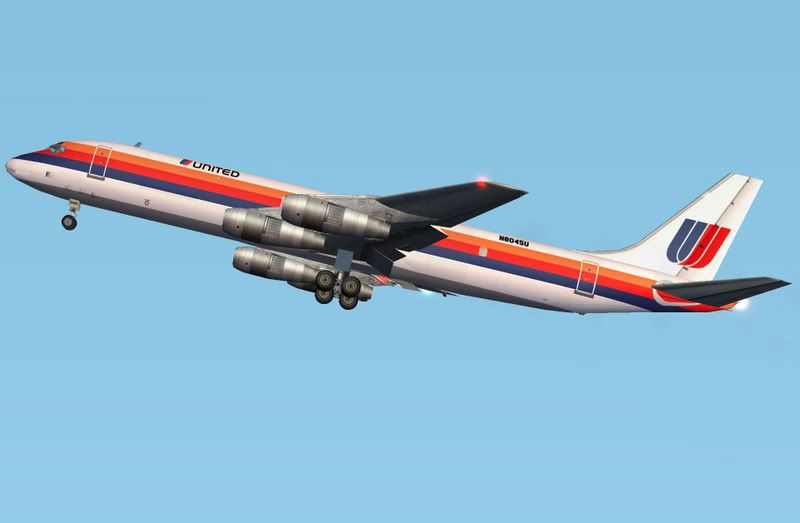
Pure freight configured DC8-54's & -55's were designated "AF" aircraft. These were stripped of all interior PAX furnishings and equipped with a reinforced main-deck, roller floor, guide rails, tie down points, 9G crash netting and had capacity for up to 13 LD3 containers or payloads of up to 95,000lb.
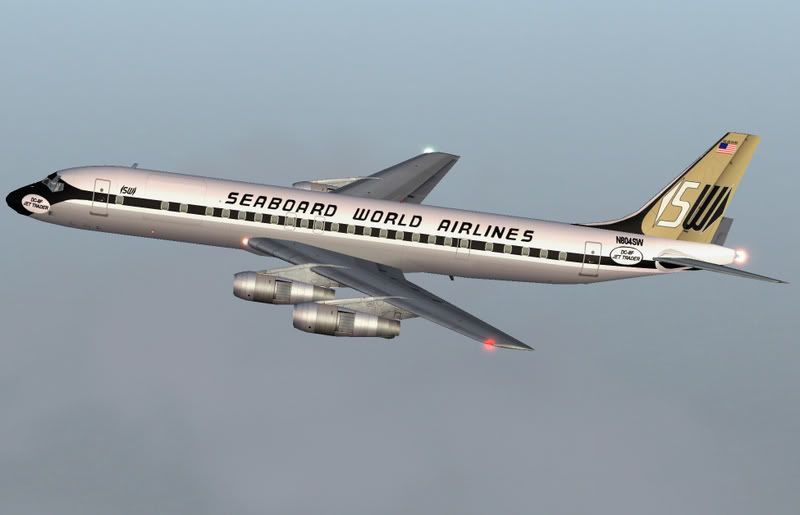
Convertible DC8-54's & -55's were designated "F" & "CF" aircraft and featured portable cabin bulkheads promoting flexible maindeck PAX/freight capacity in a cabin which could be reconfigured for either pure freight/PAX capacity within 2 hours. Both versions featured strengthened floors for payloads of up to 50,000lbs. Some of these aircraft were conspicuous by inclusion of additional center rear fuselage located PAX emergency exits on both port and starboard sides.
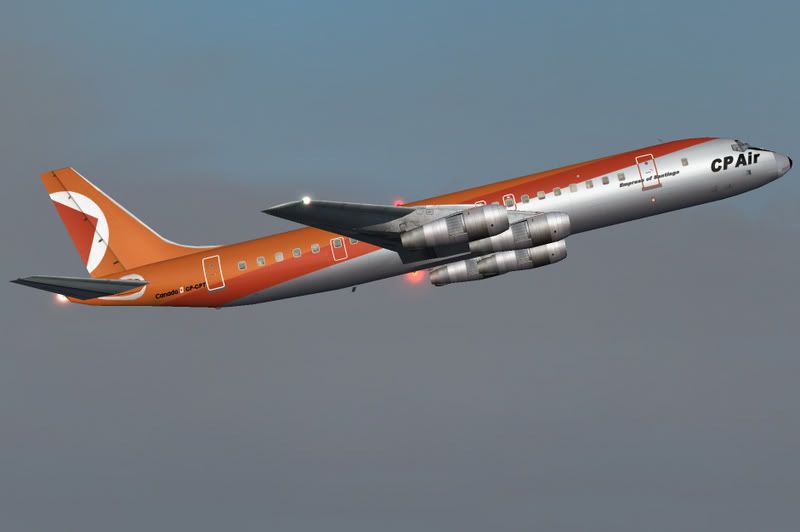
Some PAX configured DC8-55's were designated "L" & "AB" (reference to their aft presure bulkhead location). "L" versions retained the standard bulkhead position and PAX capacity of previous DC8's (as operated by Garuda Indonesian Airways, Japan Air Lines, and KLM Royal Dutch Airlines), whilst "AB" aircraft featured a pressure bulkhead relocated 6ft 4in further aft promoting capacity for up to 189 PAX (as operated by SAS, and VIASA Venezuela). Most PAX configured DC8-55's lacked forward fuselage maindeck cargo doors but benifited from greater MTOW capabilities.
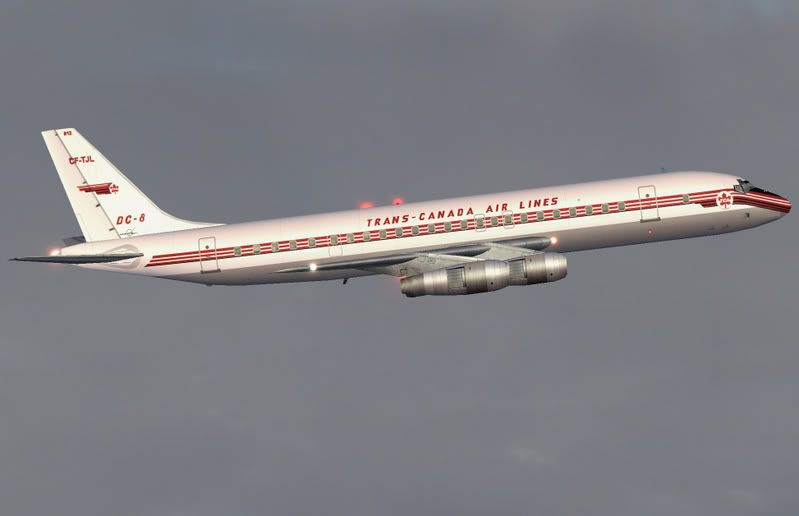
The DC8 "JET TRADER" first flew on October 29 1962 and was approved FAA certification on January 29 1963. Trans Canada Airlines took delivery of the first aircraft on January 30 1963, delivered as a -54CF. The higher MTOW series 55F was certified on June 19 1964 and first delivered to Seaboard World Airways on June 21 1964, followed by the model -55 which was awarded certification on April 25 1965 and first delivered to Japan Air Lines on October 11 1965. United Airlines became the only carrier to operate pure freight configured "JET TRADER" aircraft, acquiring 15 windowless DC8-54AF freighters between January 30 1964 and November 23 1968. The last of these (L/n #410) also became the final short fuselage DC8 built by Douglas. All DC8-50 aircraft had a fuselage length of 150ft 6in, wingspan of 142ft 5in, capacity for 132-144 PAX in a dual First/Economy Class or up to 189 PAX in a single class layout (depending upon airline/aircraft configuration). DC8-51, -52, & -53 aircraft had a MTOW of 276,000lbs, 305,000lbs, and 315,000lbs respectively and range of some 5,375nm, whilst series 54 and -55 aircraft were certified for up to 315,000lbs and 325,000lbs MTOW respectively and had range of some 6,175nm. DC8-50 aircraft were powered by 4 P&W JT3D-1 fanjet engines each rated at 17,000lb/st or alternatively either P&W JT3D-3 or JT3D-3B powerplants each rated at 18,000lb/st. Production of DC8-54 & -55 aircraft amounted to an additional 54 airframes. Sufficient to sustain production throughout the conservative early 1960's period and boosting production of the short fuselage DC8 family to a total of 294 aircraft.
By the mid 1960's traffic was on the rise. Greater capacity and longer range were being demanded of aircraft manufactuers. Congestion also began to pose new problems for most major airlines and airports around the world. Larger more capable aircraft were desperately needed to cope. To address these logistical challenges Boeing sought to develop an entirely different jetliner of mega capacity (the B747), whilst Douglas worked to transform its DC8 design into a much higher capacity and far longer ranging aircraft ...the "SUPER 60" family .... but that's another tale to be told.
By Mark CRANSTON & Dee WALDRON
The commercial jet age was born during 1952 when COMET 1 first entered BOAC service. Boeing at this time was already well advanced with its B367-80 demonstrator ...which it intended developing for both military and civil service. However there were many within both Douglas and the world airline industry whom remained skeptical about the propliner era being over and jets being the future of world civil aviation. A sizeable backlog of both DC6 & DC7 orders, the early COMET 1 tradgedies, and other logistical/economic concerns tended to justify such conservatism. Never-the-less Douglas began studying jet concepts from 1952, and like Boeing was a participant in the May 1954 USAF tender/RFP for a jet powered aerial refueller with its original DC8 proposal ...also aimed at both military and civil markets. 2 versions of this new aircraft design were proposed under "DC8-A" & "B" designations intended for domestic and overwater operations respectively. Douglas's new jetliner design conformed to a swept wing 4 engine configuration similar to that of B367-80 and featured a fuselage length of 131ft 3in, wingspan of 130ft, cabin width of 11ft, capacity for 76-110 PAX, MTOW of between 209,000lbs-249,000lbs, P&W JT3 & JT4 series turbojet powerplants, and a maximum payload range of some 3,000nm-4,000nm. The "DC8-B" specification differed from the "A" version being equipped with external underwing fuel tanks.
To Douglas's shock the USAF jet tanker contract was eventually awarded to Boeing ...essentially because having closely collaborated with the air force throughout both KC97 and B367-80 development, and by this time some 2 years in advance of its competitors, Boeing had already successfully designed and produced a suitable jet aircraft at a time most needed by the US military (B367-80 first flew on July 15 1954 ...some 2 months after the USAF RFP was first issued) whilst Douglas, despite the unquestionable reputation of its aviation engineering was still at the paper plane stage of developing its own aircraft bid. For Boeing, having also successfully developed and trialled the Flying Boom method of aerial refuelling, refinning B367-80 into what ultimately became B717/KC135 was a relatively short and simple transition. Douglas had unfortunately believed the US military would likely favour more than 1 manufactuer with regard to its tender. Loosing this lucrative USAF contract for what amounted to some 820 airframes was a critical blow to Douglas from which the company would never fully recover.
Although financially disadvantaged without the benefit of Boeing's significant government/military investment, Douglas never-the-less formally announced its DC8 program on July 7 1955 as a direct challenge to the B707 civil development of Boeing's B367-80/KC135-A and at an estimated cost of some $450 million which it had to fund independantly. In fact Douglas was not only to build a new jetliner but also forced to relocate from Santa Monica to Long Beach California to construct new facillities in support of its DC8 program. Around this time General Dynamics was also preparing to launch its CV880 jetliner. By this time the world airline industry was slowly being won over to the concept of jet air travel. For Douglas it was a case of go ahead or be left behind. In consultation with airlines around the world Douglas's original 1954 DC8 specification was progressively enhanced, evolving into an aircraft with a fuselage length of 150ft 6in, wingspan of 139ft 9in, capacity for 122-144 PAX, MTOW of between 265,000lbs-287,000lbs, and either P&W JT3C or P&W JT4A series turbojet powerplant options.
Despite its late start the Douglas design quickly found favor with many airlines for its wider cabin (increased to 11ft 6in) and immediate marketing of both domestic and overwater versions of the DC8 ...each of identical dimensions but varying operating weights and powerplant options. This consequently forced Boeing to increase cabin width of its B707 in order to remain competitive. Boeing also countered by tailoring B707's fuselage length in response to specific airline preferences. Douglas's failure to similarly compromise its basic aircraft specification, despite having designed significant stretch potential into the DC8, seriously disadvantaged aircraft sales throughout the first several years of production. Launch customer for the DC8 was Pan American World Airways with an order for 25 aircraft announced on October 13 1955. Whilst Douglas had been shocked at loosing the USAF tender to Boeing ...Boeing were equally peturbed when Pan American committed to DC8-30's on the same day it also ordered 20 B707-120's. Another large order was forthcomming from United Airlines on October 25 1955 for 30 DC8-10's. Orders quickly followed from other airlines around the world many of whom were long established and loyal Douglas clientele.
The DC8's first flight was originally planned for December 1957, with airline deliveries commencing during 1959. Construction of the first airframe began during September 1956. The DC8's fuselage was a double lobe structure comprising of titanium anti-tear strips around each frame and window/door appeture promoting a fuselage of incredible strength and durability. It also featured larger (18.5in X 15in) cabin windows than B707 spaced at 1 per seat row in often varying configurations specific to airline requirements. The DC8's wing also had less sweep than that of B707 ...for 30 degrees... compared with Boeing's 35 degree wing sweep. A number of modifications were innevitably incorporated into the DC8 design during construction of the first airframe and these ultimately delayed the aircrafts first flight until well into 1958. Although Boeing could offer more competitive aircraft pricing, Douglas had by late 1957 amassed 135 firm DC8 orders compared with 150 B707 commitments by this time accumulated by Boeing. DC8's had also been sold to more airlines than Boeing had sold B707's ...the battle of the jetliners was proving as interesting as it was close.

DC8 "Ship One" (N8008D) was finally rolled-out at Long Beach Califorina on April 9th 1958 and first flew on May 30 1958. Flight testing proceeded from Edwards AFB California until August 31 1959 when FAA type certification was approved for the DC8-10. At the time of flight testing engine thrust reversers were not available. The aircraft was instead equipped with 2 large air-brake doors located on the lower rear fuselage (port and starboard sides) immediately behind the wing trailing edge. Extending outwards when fully deployed these used the aircrafts slipstream to assist decelleration during roll-out after landing. Proving almost completly ineffective they were quickly deleted from the DC8 design when engine thrust reverser systems were developed. Early flight testing revealed the DC8 could not meet its intended 567mph cruising speed ...falling some 30mph short of Douglas's garunteed performance. Drag problems impairing speed were rectified through development of revised wing tips which were first flown on February 17 1960. Other improvements were also incorporated into the DC8's wing design throughout the test flying of later aircraft models. On May 14 1959 tests to ascertain maximum safe sink/landing rates suddenly revealed a structural weakness in the DC8 fuselage. DC8-20 "Ship Two" (N8018D), suffered a broken keel beam when the aircrafts fuselage snapped and folded down around the rear wing spar upon touchdown. This incident was non-fatal and the aircraft repaired then returned to service. All production DC8's were consequently strengthened.
In a bid to reduce the DC8/B707 sales gap Douglas intended establishing on the world market a multiplice of DC8 versions each of varying capabilities. Several aircraft participated in the types initial flight testing program which ensured FAA certification of all DC8-10, -20, -30, & -40 models by February 1961. Although Pan American was launch customer for the new jetliner, United Air Lines were first to take delivery on June 3 1959, followed by Delta Air Lines on July 21 1959. Delta also became the first airline to commence scheduled DC8 services on September 18 1959 (New York/Atlanta) ...some 2 hours ahead of United's first DC8 service on the same day.

"DC8-10" was the initial production model of the new Douglas jetliner and version first acquired by both Delta Air Lines, and United Air Lines during 1959, delivered as DC8-11's. These aircraft were designed for domestic operations and featured the 139ft 9in wingspan and 265,000lb MTOW of the original DC8 specification. Failure of these early versions to meet garunteed speed/performance forced Douglas to develop reduced drag wing tips for all series 11 aircraft which also increased wingspan by 2ft 8in. Leading Edge Wing Slots were also later incorporated promoting both reduced stalling speeds and a 7,000lb increase in MTOW. Upgraded DC8-11's were redesignated DC8-12's and recertified on July 1 1960. A total of 28 DC8-11's were produced. Most of these were upgraded to -12's whilst the last 5 produced were built to pure -12 specification. A significant number of these aircraft were later converted to series 30 and -50 models during the early 1960's. DC8-12 aircraft had a fuselage length of 150ft 6in, wingspan of 142ft 5in, MTOW of 273,000lbs, capacity for 105-118 PAX in a dual First/Economy Class cabin (depending upon airline configuration), range of some 3,734nm, and were powered by 4 P&W JT3C-6 turbojet engines (with Water/Methanol injection) each rated at 13,500lbs/st.

November 29 1959 saw first flight of the "DC8-20" which was approved FAA certification on January 19 1960. Eastern Air Lines, and National Airlines took delivery of the first series 20's on January 3 and February 7 respectively, delivered as DC8-21's. This aircraft represented a more powerful version of the original domestic model intended for hot and high operations. The redesigned wingtips (applied to all DC8's from series 12-61 models) and Leading Edge Wing Slots incoporated into all models from L/n #30 and retrofitted to earlier deliveries, were first trialled on a DC8-20 during the flight testing program. 34 DC8-20's were produced. A number of these were also later upgraded to series 30 and -50 aircraft during the 1960's. A very small number of these aircraft were even converted to freighters during the 1970's, resdesignated DC8-20F and remained in service until the early 1980's such as very rare examples which served Southern-Air Transport, and Aeroleon. DC8-21 aircraft had a fuselage length of 150ft 6in, wingspan of 142ft 5in, MTOW of 276,000lb, capacity for 105-118 PAX in a dual First/Economy Class cabin (depending upon airline configuration), range of some 4,045nm, and were powered by 4 P&W JT4A-3 turbojet engines each rated at 15,800lbs/st. Sensing it was at risk of being outclassed by Douglas, the DC8-20 forced Boeing to respond with B707-220 as an alternative to its underpowered B707-120 until advent of the B707-320.

3 versions of "DC8-30" were developed by Douglas and became first of the new intercontinental series aircraft of greater power, operating weights, capacity, and range ...intended to counter B707-320. DC8-31 first flew on February 21 1959 and trialled a 1.5 degree cruise flap setting intended to further improve flight/cruise performance. This modification delayed FAA certification of the series 31 until March 30 1960 but was incorporated into all production DC8's from L/n #33. FAA certification of the higher MTOW DC8-32 was approved on February 1st 1960, followed by the series 33 of further increased MTOW on November 28 1960. Pan American World Airways took delivery of the first series 30 aircraft on February 7 1960, delivered as DC8-32's followed also by the first -33 model on December 15 1960. Pan American Grace Airways took delivery of the first DC8-31 on April 6 1960. The first DC8's for foreign customers also became series 30 aircraft for KLM Royal Dutch Airlines, and SAS, delivered as series 32's on March 19 and 31 1960 respectively. Douglas produced a total of 57 DC8-30's (compared with 69 slightly larger and higher capacity B707-320's built by Boeing). Many of these were upgraded to later model 30 specification and series 50 aircraft throughout the 1960's. Some of these aircraft were converted to freighters during the 1970's, redesignated DC8-30F such as rare examples which served ANDES, and Zantop International. All DC8-30 aircraft had a fuselage length of 150ft 6in, wingspan of 142ft 5in, capacity for 132-144 PAX in a dual First/Economy Class cabin (depending upon airline configuration), range of some 4,700nm. DC8-31's & -32's had a MTOW of 300,000lbs and 310,000lbs respectively and were both powered by 4 P&W JT4A-9 turbojet engines each rated at 16,800lbs/st, whilst series -33 aircraft were certified for up to 315,000lbs MTOW and were powered by P&W JT4A-11 turbojet engines each rated at 17,500lbs/st.

Late 1950's development of fanjet engine technology of improved performance and fuel economy promoted a new generation of both DC8 & B707 jetliners. "DC8-40" became the first of the DC8 family to benefit from this revolutionary new powerplant ...the RR Conway fanjet engine. Like preceeding series 30 aircraft, the -40 model was also produced in 3 versions each of progressively higher operating weights. First flying on July 23 1959 the DC8-41 was approved FAA certification on March 24 1960, followed by the series 42 on April 26 1960, then the -43 model on February 11 1961. The DC8-43 also introduced yet another performance enhancing modification in the form of a 4% wing chord extension (from wing root to tip) with a sharper leading edge promoting slightly higher speed, additional fuel capacity, and increased range. This enhancemnt was incorporated into all production DC8's from L/n #148 and also retrofitted to earlier series 40 aircraft upon airline request. The first DC8-41 was delivered to Trans Canada Airlines on February 7 1960, followed by the first series 42 delivered to Alitalia on April 28 1960, then the first -43 model which was delivered to Canadian Pacific Airlines on February 21 1961. 32 DC8-40's were produced by Douglas between 1959 and 1963 (compared with 37 RR Conway powered B707-420's built by Boeing over a similarly short duration). Again some early -40 series DC8's were upgraded to later 40 model specification and to series 50 aircraft throughout the 1960's. A very small number of these aircraft were also converted to freighters during the 1970's, redesignated DC8-40F such as very rare examples which served AeroPeru Cargo, and ARCA Colombia. All DC8-40 aircraft had a fuselage length of 150ft 6in, wingspan of 142ft 5in, capacity for 132-144 PAX in a dual First/Economy Class cabin (depending upon airline configuration), range of some 4,875nm, and were powered by 4 RR Conway 509 fanjet engines each rated at 17,500lbs/st. DC8-41's had a MTOW of 300,000lbs, whilst series 42 and -43 models were certified for up to 310,000lbs and 315,000lbs MTOW respectively. Both DC8-40 and the RR Conway powerplant were quicky overtaken by further advances in jet engine technology when even higher performance P&W series fanjet engines became available during the early 1960's.

On August 21 1961 a DC8-43 earned distinction of becomming the first civil jetliner to exceed the sound barrier. In a planned/controlled sortie over the Askana Tracking Range at Edwards AFB California, the aircraft attained a speed of MACH 1.012/662mph (TAS) in a shallow dive from FL520 which was also an altitude record for a civil jetliner. This particular aircraft was later delivered to Canadian Pacific Airlines as CF-CPG on November 15 1961 and operated until May 1 1980 when it was finally retired from service and sold for scrap.

Powered by P&W JT3D series fanjet engines of superior performance, fuel economy, and environmental acceptability, "DC8-50" became the definitive short fuselage DC8 version, produced in several sub types of varying configuration and capability in response to the B707-320B and VC10 then entering the world market. DC8 "Ship One" was upgraded to series 50 specification with new fanjet powerplants contained within redesigned engine nacelles which were attached to the original DC8-10 pylons. First flying in this configuration (but without the aerodynamic enhancements applied to previous DC8 versions) on December 20 1960 the aircraft was approved FAA certification on October 10 1961. All production DC8-50's featured redesigned engine pylons.

3 initial PAX versions of the -50 model were marketed ...DC8-51 first delivered to Trans Canada Airlines on November 6 1961, followed by the increased MTOW -52 certified on May 1 1961 and first delivered to IBERIA on May 27 1961, then the even higher MTOW -53 first delivered to KLM Royal Dutch Airlines on April 3 1961. This particular aircraft (PH-DCI) was delivered early to KLM and operated performance/reliability testing (flying Long Beach/Rome/Amsterdam/Caracus/Long Beach in support of the series 50 type certificate) between April 21 and April 28 1961 when FAA certification was approved for DC8-53.

The DC8-50's payload/range capabilities were demonstrated between February 20 and 23 1962 when DC8-53 N9608Z, named "Pacific Pacer" and operated in a promotional Douglas livery, flew Seattle/Tokyo direct with a 41,000lb payload, then Tokyo/Miami direct over a distance of 8,702nm in 13hrs 52mins. Some 10,000lbs of fuel remained aboard the aircraft upon shutdown in Miami. A total of 88 series 51, -52, & -53 DC8's were built by Douglas (in comparason to 174 B707-320B's built by Boeing). An additional number of DC8-20, -30, & -40 models were upgraded to -50 series aircraft during the 1960's. Many of these also were converted to freighters throughout the 1970's and 1980's, redesignated DC8-50F.
Despite its advantages over previous DC8 versions, the DC8-50's entry into the world market also coincided with a global slump in the sales of new jetliners. The rush by most major airlines during the late 1950's to modernize with jet equipment suddenly resulted in a period of excess capacity, experienced by most carriers during the early 1960's. The number of DC8's & B707's sold between 1962 and 1964 dwindled sharply as airlines awaited traffic growth before ordering new aircraft.

During this period Douglas attempted to market DC8's to the USAF as "JETMASTER" transports, and later as a contender for prospective AWACS, ECM, Anti-Submarine, Aerial Refuelling, and Medical Evacuation roles. Whilst military interest was generated no orders were forthcomming as the USAF elected to remain with Boeing and its established B707 derived C135/Bairframe.

At least 1 DC8 did enter a specialist military tatical air service role. During 1988 the US Navy purchased an ex United Airlines DC8-54F (N8048U L/n #276). This particular aircraft (163050) was upgraded to provide support for Fleet Electronic Warfare Missions/C3 threat simulation as well as general transport deployment. Aquiring the Navy "EC-24A" designation this aircraft was operated by Chrysler Technologies on behalf of the US Navy until decommissioned during 1998.
Douglas might have closed the DC8 production line early had not another niche opportunity been realised. Just as advent of civil jetliners promoted carriage of greater volumes of passengers further and faster than ever before, so too expanded potential for global import/export cargo giving birth to a whole new industry of dedicated jet air freight, to which the DC8's flexibility and lifting capability were ideally suited. This spawned development of the final short fuselage variant of the DC8 family ...the "JET TRADER"... marketed as series 54 & -55 aircraft in pure freight, PAX, or mixed PAX/freight convertible configurations capable of full trans-Atlantic range. Most of these aircraft featured a 140in X 86in maindeck freight door located on the forward fuselage in addition to standard lower fuselage freight/baggage hatches starboard side.

Pure freight configured DC8-54's & -55's were designated "AF" aircraft. These were stripped of all interior PAX furnishings and equipped with a reinforced main-deck, roller floor, guide rails, tie down points, 9G crash netting and had capacity for up to 13 LD3 containers or payloads of up to 95,000lb.

Convertible DC8-54's & -55's were designated "F" & "CF" aircraft and featured portable cabin bulkheads promoting flexible maindeck PAX/freight capacity in a cabin which could be reconfigured for either pure freight/PAX capacity within 2 hours. Both versions featured strengthened floors for payloads of up to 50,000lbs. Some of these aircraft were conspicuous by inclusion of additional center rear fuselage located PAX emergency exits on both port and starboard sides.

Some PAX configured DC8-55's were designated "L" & "AB" (reference to their aft presure bulkhead location). "L" versions retained the standard bulkhead position and PAX capacity of previous DC8's (as operated by Garuda Indonesian Airways, Japan Air Lines, and KLM Royal Dutch Airlines), whilst "AB" aircraft featured a pressure bulkhead relocated 6ft 4in further aft promoting capacity for up to 189 PAX (as operated by SAS, and VIASA Venezuela). Most PAX configured DC8-55's lacked forward fuselage maindeck cargo doors but benifited from greater MTOW capabilities.

The DC8 "JET TRADER" first flew on October 29 1962 and was approved FAA certification on January 29 1963. Trans Canada Airlines took delivery of the first aircraft on January 30 1963, delivered as a -54CF. The higher MTOW series 55F was certified on June 19 1964 and first delivered to Seaboard World Airways on June 21 1964, followed by the model -55 which was awarded certification on April 25 1965 and first delivered to Japan Air Lines on October 11 1965. United Airlines became the only carrier to operate pure freight configured "JET TRADER" aircraft, acquiring 15 windowless DC8-54AF freighters between January 30 1964 and November 23 1968. The last of these (L/n #410) also became the final short fuselage DC8 built by Douglas. All DC8-50 aircraft had a fuselage length of 150ft 6in, wingspan of 142ft 5in, capacity for 132-144 PAX in a dual First/Economy Class or up to 189 PAX in a single class layout (depending upon airline/aircraft configuration). DC8-51, -52, & -53 aircraft had a MTOW of 276,000lbs, 305,000lbs, and 315,000lbs respectively and range of some 5,375nm, whilst series 54 and -55 aircraft were certified for up to 315,000lbs and 325,000lbs MTOW respectively and had range of some 6,175nm. DC8-50 aircraft were powered by 4 P&W JT3D-1 fanjet engines each rated at 17,000lb/st or alternatively either P&W JT3D-3 or JT3D-3B powerplants each rated at 18,000lb/st. Production of DC8-54 & -55 aircraft amounted to an additional 54 airframes. Sufficient to sustain production throughout the conservative early 1960's period and boosting production of the short fuselage DC8 family to a total of 294 aircraft.
By the mid 1960's traffic was on the rise. Greater capacity and longer range were being demanded of aircraft manufactuers. Congestion also began to pose new problems for most major airlines and airports around the world. Larger more capable aircraft were desperately needed to cope. To address these logistical challenges Boeing sought to develop an entirely different jetliner of mega capacity (the B747), whilst Douglas worked to transform its DC8 design into a much higher capacity and far longer ranging aircraft ...the "SUPER 60" family .... but that's another tale to be told.
By Mark CRANSTON & Dee WALDRON






